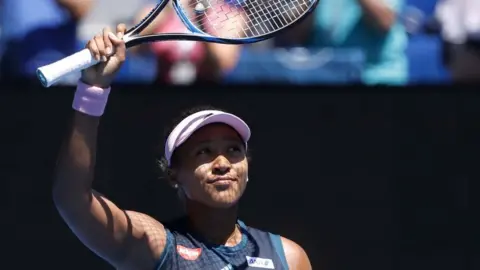Japan's tennis champion Naomi Osaka inspires manga character
 Reuters
ReutersJapanese tennis star Naomi Osaka has inspired a new manga character who will debut in Nakayoshi magazine next month.
The three-time Grand Slam winner shared a picture of her character on Twitter on Sunday - complete with pink hair, an orange visor and a tennis racket.
Osaka, the world's highest-paid female athlete, said she and her sister grew up reading manga and were excited about the new comic.
Her sister, Mari Osaka, has been involved with the character's creation.
"Growing up reading manga/watching anime was something that bonded me and my sister immensely so this is really exciting for both of us," the tennis champion tweeted.
Allow X content?

Nakayoshi - one of Japan's oldest and most influential manga magazines - said the new manga, called "Unrivalled Naomi Tenkaichi", will be unveiled in the issue released on 28 December.
Osaka, 23, was born to a Japanese mother and a Haitian father in the city with which she shares her surname in western Japan. The family moved to New York when she was three years old.
"To feature a female character who is half-Haitian and half-Japanese, especially one so accomplished and universally admired, is a major leap forward in manga cultural awareness and representation," Roland Kelts, a visiting professor of culture, media and society at Tokyo's Waseda University, told the BBC.
Bi-racial characters are a rarity in manga although they have featured in the past.
When they emerge they are usually half-white and half-Japanese, said Dr Kelts, whose book Japanamerica explores the influence of Japanese pop culture in the US.
He puts that down to Japan traditionally seeing itself as a racially homogenous country with few manga artists branching out beyond their perceived ethnic identity.
 Reuters
ReutersA previous attempt to portray Osaka as a cartoon character in an animated advert was quickly embroiled in controversy.
The noodle company Nissin was accused of "whitewashing" the star in the drawing by depicting her with white skin and light brown hair.
"I'm tan, it's pretty obvious," Osaka told a press conference last year, adding that the company had apologised to her directly.
The athlete has been a popular endorsement figure in Japan but she has also been the target of intense racism.
In October 2019 a Japanese comedy duo apologised after they reportedly said Osaka, who had just won the Pan Pacific Open, "needed some bleach" and was "too sunburned".
Their management company also apologised, without naming the tennis player, for their "remarks inconsiderate of diversity in an era where diversity is respected".
Earlier this year Osaka displaced her US tennis rival Serena Williams as the world's highest-paid female athlete.
She has increasingly used her influence to speak out against racial injustice.
At the recent US Open, for every round she wore a new mask bearing the name of a black victim of alleged police or racist violence in the US.

